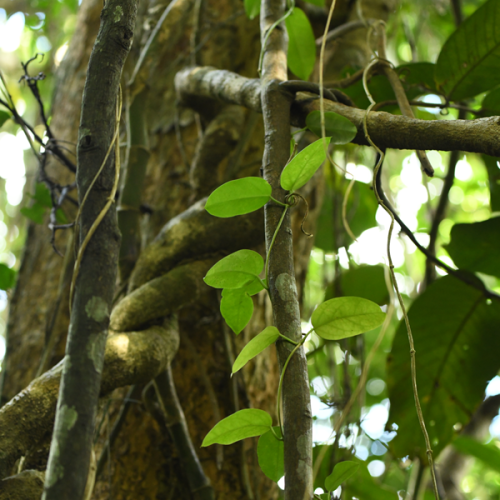Family Name
MENISPERMACEAE
Scientific Name
Tinospora crispa (L.) Hook. f. & Thomson
Synonyms
Chasmanthera crispa (L.) Baill.; Cocculus bantamensis Blume; C. crispus (L.) DC.; C. rimosus Blume; C. verrucosus (Roxb.) Wall.; Menispermum bantamense (Blume) Spreng; M. crispum L.; M. rimosum (Blume) Spreng.; M. tuberculatum Lam.; M. verrucosum Roxb.; Tinospora gibbericaulis Hand.-Mazz; T. mastersii Diels; T. rumphii Boerl.; T. thorelli Gagnep; T. tuberculate (Lam.) Beumee ex K. Heyne; T. verrucosa (Roxb.) W.Theob.
Local Names
Gatasan (Tag.); makabuhai (Tag., Bis., Ilk.); paliaban (Bis.); panauan (Bis.); pañgiauban (Bis.); sañgaunau (Bag.); taganagtagua (Bis.)
Botanical Description
A herbaceous vine; Stems are fleshy, with prominent blunt tubercles whereas younger stems are slightly fleshy, thin epidermis, membranous, brownish, and glabrous; Leaves are large, heart shaped 6–12 cm long and 7–12 cm wide; petioles are glabrous and 5–15 cm long; leaf blade is slightly fleshy, both surfaces glabrous and very delicate when dried; contains two or three small and yellow or greenish yellow color flowers which are fascicled; Inflorescence in axillary racemes. Male inflorescences is very slender, 5–10 cm or longer; Male flower has six green and glabrous sepals in two whorls; outer three are ovate (1 mm) while inner three are obovate; 3–6 yellow color petals and six stamens equivalent in length to petals; Female inflorescences 2–6 cm long, mostly one flower per node; Female flower has sepals and petals as in male; Fruit drupe, 7–8 mm in length.
Distribution Ecology
Southern China, India, Sri Lanka, Vietnam, Laos, Cambodia, Thailand, Malaysia, Indonesia, Philippines (Luzon, Culion,Basilan). Primary rain forest and mixed deciduous forest. Can also be found in secondary vegetation after logging and in hedges, at elevation up to 1,000 meters.
Other Economic Uses
Stem decoction used to purify blood, treat stomachache, fever, worms, gonorrhea and skin allergy/ Stem and root extract used to relieve malaria, high blood pressure, diabetes and bacterial abscesses.
Volume Estimate
No information available

